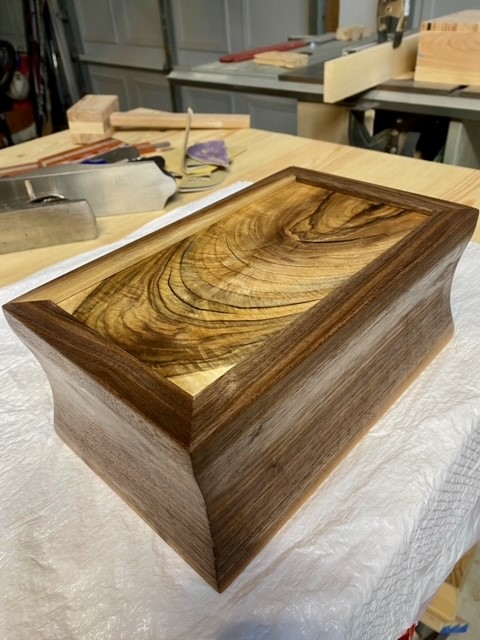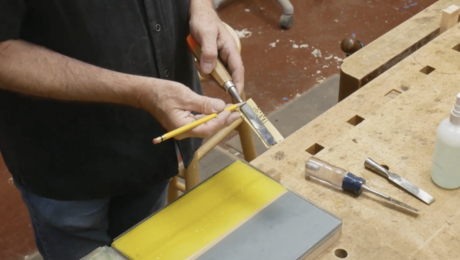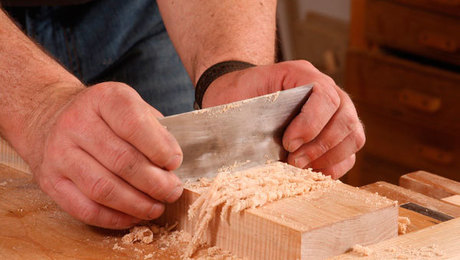STL256: Just’a planin’ and a scrapin’
Mike and Ben finish out the year answering a batch of questions about flattening plane irons, micro bevels, hot card scrapers, and touching up a glue line.Question 1:
From Michael:
Hey I have a quick question about a visible glue line I have on a small project. I am working on an urn for a friend made of Black Walnut and English Walnut. I made a mistake and used Titebond 2 on this project. Do you have any tips for fixing this or covering it up. Thanks for any help you might have.
 |
 |
Question 2:
From Thomas:
I recently had a harrowing near miss involving one of my tools. I complaining to someone I was working with about the challenge of planing quartersawn cherry. We were away from my shop and he asked if I had brought a card scraper with me, which I hadn’t.
In slow motion, I saw this person pick up my bad axe sash saw and with the tote sticking straight up in the air, he was about to use the front edge of the plate like it as a card scraper. I voiced my disapproval, in the form of “no no no don’t stop stop bad bad”, and rescued my poor saw.
Have you ever seen or heard of this? Cutting up an old saw to make scrapers is one thing, but….
This got me thinking about tool hacks, for lack of a better term. In other words, using tools or parts of tools in ways they aren’t intended, such as the classic ones of using a lever cap as a screwdriver for your chip breakers, or using your chisels as scrapers or can openers, aka how to ruin your edge in one easy step.
– What are some tool hacks that you like and/or loathe?
– Another topic to discuss, do you loan tools out? How do you address taking care of them?
Question 3:
From Ken:
I am a believer in the micro bevel (25 degree primary and 30 degree micro).
Question: Should I put a micro bevel on my smaller chisels (1/4”, 1/8”, 1/16”) and mortising chisel (in my case only a 3/8”). If important, all but the shop made 1/16” chisels are Robert Sorby. If this topic has been covered before, my apologies for missing it.
 |
What’s in a bevel angle? |
Question 4:
From Bob:
I have another sharpening question. I bought a Lie Nielson #5 and a block plane. I have a 600 grit, 1200 grit and 8000 grit stone for sharpening, and a diamond flattening plate to keep the stones flat. 2 questions. How long should it take to flatten the back of a Lie Neilson plane blade? The 2 that I have seem to be taking hours to get an even scratch pattern. I have flattened the stones by putting a curley pencil mark on them and rubbing them on the plate until the mark is gone. I’d also like to know how long a diamond flattening plate should last. Mine is not nearly as coarse as when it was new, although it still seems to flatten stones quickly.
 |
Sharp blades start with a flat back |
Question 5:
From Jake:
Every time I use the card scraper for more than five minutes I end up with blisters in this same pattern on my index finger and thumb. Am I doing something wrong or is this par for the course ?
 |
How to Sharpen a Card Scraper |
Every two weeks, a team of Fine Woodworking staffers answers questions from readers on Shop Talk Live, Fine Woodworking‘s biweekly podcast. Send your woodworking questions to shoptalk@taunton.com for consideration in the regular broadcast! Our continued existence relies upon listener support. So if you enjoy the show, be sure to leave us a five-star rating and maybe even a nice comment on our iTunes page.





















Comments
Do you have a link to the "Mark Scofield picture frame jig" that you mention at 10:10?
I can't believe I left that one off!
https://www.finewoodworking.com/videoworkshop/2012/08/building-custom-picture-frames
To make Diamond Plates last longer use lots of water, under running water when lapping water stones. If you do not, the stone can load up and will rip the diamonds from the binder. I use Windex when used to hone steel.
Most Diamond Plates load up, but the diamonds are still intact, and just need cleaning. Make a thin paste of Barkeepers Friend on a wet plate, let sit for 5-10 minutes, then scrub with a stiff brush, brass toothbrush or stiff fingernail brush to remove the load up. It will refresh a plate.
I too have Diamond Plates from most makers that are well over 10 years old and see use almost daily, to lap water and natural stones. Do not use Diamond Plates on Arkansas stones or other Novaculite stones, they will quickly rip the diamonds from the binder and trash the plate.
If you lap a lot of stones, a 140-grit plate is your friend.
I was hoping you would address how appropriate using the end of the backsaw as a scraper is.
I mistakenly bought a vintage saw on Ebay and saw no path to rehabbing it. So, I cut two card scrapers out of it with an angle grinder, dressed the long edges and have used them for a couple years. they work great. Mine are not the best due to slight pitting on the saw plate. But they do work well for me.
I can't imagine using a working saw for this. The top edge is not dressed at all and probably won't make anything other than a bit of sawdust.
Log in or create an account to post a comment.
Sign up Log in